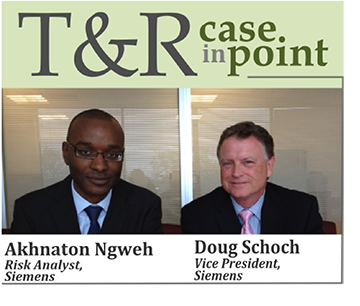 Siemens AG is a globalpowerhouse. It produces electronics and electrical engineeringproducts for companies in the manufacturing, energy, and healthcaresegments in more than 290 major production facilities worldwide,and it provides infrastructure solutions to cities and metropolitanareas.
Siemens AG is a globalpowerhouse. It produces electronics and electrical engineeringproducts for companies in the manufacturing, energy, and healthcaresegments in more than 290 major production facilities worldwide,and it provides infrastructure solutions to cities and metropolitanareas.
Siemens Capital Company LLC (SCC), a wholly owned subsidiary ofSiemens AG, is the central treasury service provider forSiemens-affiliated companies in the Americas. It is one of fourSiemens treasury centers globally.
|Several years ago, Siemens launched a credit warehouse programdesigned to improve transparency into commercial customer creditdata across the company. Treasury & Riskcaught up with vice president Doug Schoch and risk analyst AkhnatonNgweh to discuss the 'why,' the 'how,' and the outcome of theproject.
|T&R: The credit warehouse was amajor undertaking; Siemens Capital Company even spun off a newsubsidiary, Siemens Credit Warehouse, Inc., to manage the programin the U.S. What were the pain points that led your company to takesuch drastic measures to gain better insights into customer creditdata?
|Doug Schoch: Like many companies intoday's world, Siemens was dealing with large amounts of commercialcustomer data, and synthesizing and leveraging this information wasan ongoing challenge. We have a lot of business units across theglobe, and it was difficult for any one group to gain a holisticperspective on the receivables portfolio of Siemens as a whole.
| Each credit team at the locallevel was managing customers' credit risk separately. That meantthat although each team limited the exposure of its business unitto credit risk from any particular counterparty, we knew that thecompany overall had large exposures to some of our biggestcustomers. As the world economy began to falter, and some of ourmajor customers started having financial difficulties, we needed tobe able to see which companies posed extraordinary credit risk toSiemens globally. That just wasn't feasible when the data wasstored in dozens of different databases around the world.
Each credit team at the locallevel was managing customers' credit risk separately. That meantthat although each team limited the exposure of its business unitto credit risk from any particular counterparty, we knew that thecompany overall had large exposures to some of our biggestcustomers. As the world economy began to falter, and some of ourmajor customers started having financial difficulties, we needed tobe able to see which companies posed extraordinary credit risk toSiemens globally. That just wasn't feasible when the data wasstored in dozens of different databases around the world.
T&R: What track did Siemens taketo resolve this challenge?
|DS: Well, the company decided in 2008 toaddress this dilemma. We started consolidating short-termreceivables data from multiple business units into one centralgroup in treasury. The goals were to increase credit risk awarenessacross Siemens, enable the centralized group to actively manage thecompany's credit risk on a global scale, and provide an additionalsource of liquidity for Siemens. That's how the global SiemensCredit Warehouse program was created.
||
T&R: So, how does the SiemensCredit Warehouse work?
|DS: On a daily basis, Siemens businessunits transfer their trade receivables data to the program's globaldatabase, which is hosted in Germany. We developed the databasesoftware in-house, based on SAP technology. Local units' SAP ERPsystems connect to the credit warehouse database, and their data isdelivered to the program via a file transfer. The data isaggregated and enhanced with internal credit risk ratings andcredit reports. The Siemens Credit Warehouse then makesconsolidated information on Siemens' commercial customers availableinternally through a web-based application.
|So the program synthesizes commercial receivables data, thenshares a holistic view of Siemens' commercial customers through theone global platform. Over 1,500 Siemens employees are nowleveraging consolidated information from over 270 Siemens businessunits around the world. They're able to access up-to-dateinformation about receivables exposures, risk profiles, and creditdata on Siemens customers.
||
T&R: How does this create valuefor Siemens?
|Akhnaton Ngweh: Now Siemens businessunits are able to make more-informed decisions, work moreefficiently, reduce credit information expenses, and collaborate oncommon challenges.
||
T&R: OK, how does the SiemensCredit Warehouse help the company make better-informed businessdecisions?
|AN: Various groups within Siemens areusing the aggregated information about receivables exposures tobetter understand the company's relationships with commercialcustomers and suppliers. Local units can identify the majorbusiness partners of Siemens as a whole, and they can communicatewith other Siemens entities to understand payment experience andterms for customers they share with other units. So one businessunit can avoid extending additional credit to a customer that has apast-due account with another unit.
|The Siemens Credit Warehouse team provides internal credit riskratings to indicate the creditworthiness of Siemens' commercialcustomers. These risk ratings are based on information obtainedfrom financial reports, external rating agencies, external creditdata, and Siemens' customer default experiences. The risk ratingssupport local credit teams in their day-to-day responsibilities. Acustomer's rating profile provides a comprehensive, high-levelperspective on the customer's overall risk, and the standardizedmethodologies of the risk ratings help ensure consistent handlingand comparisons across Siemens.
|By combining this new outlook with their own expertise, localteams can make more-informed decisions. Siemens units are using therisk ratings in areas such as up-front credit approval,collections, and general reserve setting.
||
T&R: What other benefits does thecredit warehouse offer?
|AN: Local business units are able to savemoney on the cost of credit information. Because the creditwarehouse makes credit reports and internal risk ratings availableon one platform for new and existing commercial customers, unitsevaluating a commercial customer for the first time can re-usecredit information already compiled for other Siemens entities. Byusing a central platform, we're reducing duplication and optimizingthe company's spend on credit information.
|The local teams are constantly being challenged to achieve morewith tight resources. The risk ratings can help in this regardbecause they provide a quick, reliable, and cost-effective measureof credit risk. Local business units are able to improve efficiencyby incorporating the internally generated credit risk ratings intotheir existing credit processes. The Siemens Credit Warehousesupports the smooth integration of these risk ratings at the unitlevel by offering an automated solution that can transfer riskrating information into each business unit's ERP system. Anincreasing number of Siemens business units are now implementingthe automated solution in order to build the risk ratings intotheir standard processes.
|In addition to the Siemens Credit Warehouse credit database,business units connected to the credit warehouse can access a dailyrating-change report, which contains up-to-date risk ratings ontheir customers. This report can be imported automatically into thebusiness unit's SAP ERP system with a specific function. Some ITprogramming is required on the business unit's side to enable theautomated data import.
||
T&R: You mentioned collaboration,as well. How does the program enable collaboration acrossSiemens?
|AN: Collaboration among local creditteams on the ground, and between those teams and the Siemens CreditWarehouse team, creates new opportunities to raise risk awarenessacross Siemens. Participating units have begun sharing ideas anddiscussing their common challenges, and the credit warehouse isenabling those conversations. The Siemens Credit Warehouse grouphas also organized numerous collaborative education sessions, whichhave highlighted best practices within Siemens. Local teams arelearning from one another, and the exchange of information ispromoting process improvement.
||There's one other big component of the program that we haven'ttalked about. The Siemens Credit Warehouse also provides political-and credit-risk protection by purchasing eligible receivables fromSiemens business units. Participating business units receive cash,either upon payment by the customer or, in case of customerdefault, from the Siemens Credit Warehouse. Eligible receivablesthat are overdue for more than 90 days are treated as defaults. Thebusiness unit selling a receivable to the Siemens Credit Warehouseis responsible for servicing activities such as collections andreceivables management.
||
T&R: What challenges did yourteam—or does your team still—face in convincing business units touse the Siemens Credit Warehouse services?
|DS: Our local units have been successfulusing their own methods to assess credit risk, and they're veryknowledgeable about the ins and outs of their own processes. Sosome of the credit teams at the local level may be reluctant toembrace new concepts such as our internally developed credit riskratings. The logic behind the risk ratings is still relatively newto the business units.
||
T&R: What are you doing toencourage adoption of the risk ratings?
|DS: Ongoing education is key. The SiemensCredit Warehouse team is learning from the local units, and viceversa. The SCW risk advisory team has been visiting variousbusiness units and hosting peer discussions. These sessions arevery valuable to the SCW team, as they provide us with feedback andhelp us align our advisory services and tools with the needs of thebusiness units.
||
T&R: Where will the SiemensCredit Warehouse program go from here?
|DS: The program has come a long way, andits journey of providing value continues. Ongoing communicationwith the local business units will be essential for the creditwarehouse service to remain relevant. This collaboration will paydividends down the road as the program continues to tailor itsservices and systems. The future looks promising, as the SCW groupand local units continue to work together to unlock the potentialof one of Siemens' unique and most important business assets: ourreceivables data.
|For further information on the Siemens Credit Warehouseprogram, feel free to contact Doug Schoch at [email protected]and Michael Pschiuk at [email protected].
Complete your profile to continue reading and get FREE access to Treasury & Risk, part of your ALM digital membership.
Your access to unlimited Treasury & Risk content isn’t changing.
Once you are an ALM digital member, you’ll receive:
- Critical Treasury & Risk information including in-depth analysis of treasury and finance best practices, case studies with corporate innovators, informative newsletters, educational webcasts and videos, and resources from industry leaders.
- Exclusive discounts on ALM and Treasury & Risk events.
- Access to other award-winning ALM websites including PropertyCasualty360.com and Law.com.
*May exclude premium content
Already have an account? Sign In
© 2024 ALM Global, LLC, All Rights Reserved. Request academic re-use from www.copyright.com. All other uses, submit a request to [email protected]. For more information visit Asset & Logo Licensing.







